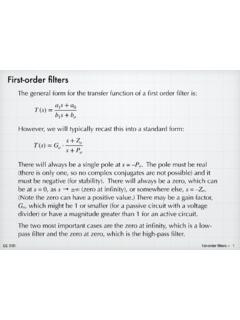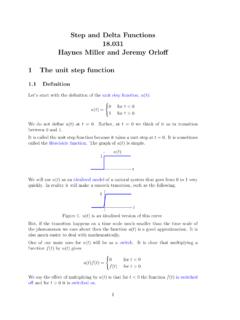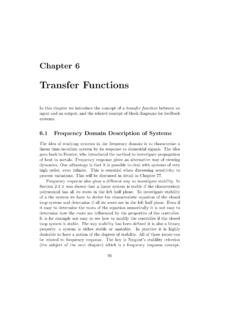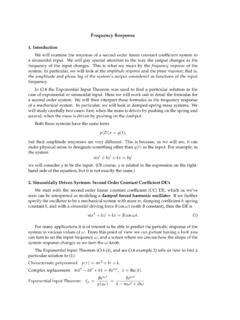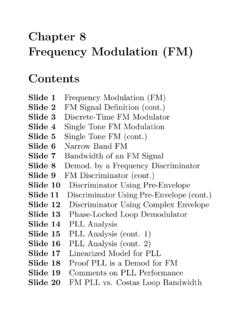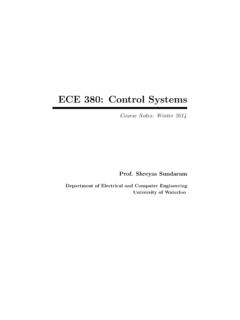Transcription of Convolution, Correlation, Fourier Transforms
1 Convolution, Correlation, & Fourier Transforms James R. Graham 10/25/2005 Introduction A large class of signal processing techniques fall under the category of Fourier transform methods These methods fall into two broad categories Efficient method for accomplishing common data manipulations Problems related to the Fourier transform or the power spectrum Time & Frequency Domains A physical process can be described in two ways In the time domain, by the values of some some quantity h as a function of time t, that is h(t), - < t < In the frequency domain, by the complex number, H, that gives its amplitude and phase as a function of frequency f, that is H(f), with - < f < It is useful to think of h(t) and H(f) as two different representations of the same function One goes back and forth between these two representations by Fourier Transforms Fourier Transforms If t is measured in seconds, then f is in cycles per second or Hz Other units , if h=h(x)
2 And x is in meters, then H is a function of spatial frequency measured in cycles per meter H(f)=h(t)e 2 iftdt h(t)=H(f)e2 iftdf Fourier Transforms The Fourier transform is a linear operator The transform of the sum of two functions is the sum of the Transforms h12=h1+h2H12(f)=h12e 2 iftdt =h1+h2()e 2 iftdt =h1e 2 iftdt +h2e 2 iftdt =H1+H2 Fourier Transforms h(t) may have some special properties Real, imaginary Even: h(t) = h(-t) Odd: h(t) = -h(-t) In the frequency domain these symmetries lead to relations between H(f) and H(-f) FT Symmetries h(t) real H(-f) = [ H(f) ]* h(t) imaginary H(-f) = -[ H(f) ]* h(t) even H(-f) = H(f) (even) h(t) odd H(-f) = - H(f) (odd) h(t) real & even H(f) real & even h(t) real & odd H(f) imaginary & odd h(t) imaginary & even H(f) imaginary & even h(t) imaginary & odd H(f) real & odd Elementary Properties of FT h(t) H(f) Fourier Pairh(at) 1aH(f/a) Time scalingh(t t0) H(f)e 2 ift0 Time shiftingConvolution With two functions h(t) and g(t), and their corresponding Fourier Transforms H(f) and G(f), we can form two special combinations The convolution, denoted f = g * h, defined by ft()=g h g( )h(t )d Convolution g*h is a function of time, and g*h = h*g The convolution is one member of a transform pair The Fourier transform of the convolution is the product of the two Fourier Transforms !
3 This is the Convolution Theorem g h G(f)H(f)Correlation The correlation of g and h The correlation is a function of t, which is known as the lag The correlation lies in the time domain Corr(g,h) g( +t)h(t )d Correlation The correlation is one member of the transform pair More generally, the RHS of the pair is G(f)H(-f) Usually g & h are real, so H(-f) = H*(f) Multiplying the FT of one function by the complex conjugate of the FT of the other gives the FT of their correlation This is the Correlation Theorem Corr(g,h) G(f)H*(f)Autocorrelation The correlation of a function with itself is called its autocorrelation. In this case the correlation theorem becomes the transform pair This is the Wiener-Khinchin Theorem Corr(g,g) G(f)G*(f)=G(f)2 Convolution Mathematically the convolution of r(t) and s(t), denoted r*s=s*r In most applications r and s have quite different meanings s(t) is typically a signal or data stream, which goes on indefinitely in time r(t) is a response function, typically a peaked and that falls to zero in both directions from its maximum The response Function The effect of convolution is to smear the signal s(t) in time according to the recipe provided by the response function r(t) A spike or delta-function of unit area in s which occurs at some time t0 is Smeared into the shape of the response function Translated from time 0 to time t0 as r(t - t0) Convolution The signal s(t) is convolved with a response function r(t)
4 Since the response function is broader than some features in the original signal, these are smoothed out in the convolution s(t) r(t) s*r Fourier Transforms & FFT Fourier methods have revolutionized many fields of science & engineering Radio astronomy, medical imaging, & seismology The wide application of Fourier methods is due to the existence of the fast Fourier transform (FFT) The FFT permits rapid computation of the discrete Fourier transform Among the most direct applications of the FFT are to the convolution, correlation & autocorrelation of data The FFT & Convolution The convolution of two functions is defined for the continuous case The convolution theorem says that the Fourier transform of the convolution of two functions is equal to the product of their individual Fourier Transforms We want to deal with the discrete case How does this work in the context of convolution? g h G(f)H(f)Discrete Convolution In the discrete case s(t) is represented by its sampled values at equal time intervals sj The response function is also a discrete set rk r0 tells what multiple of the input signal in channel j is copied into the output channel j r1 tells what multiple of input signal j is copied into the output channel j+1 r-1 tells the multiple of input signal j is copied into the output channel j-1 Repeat for all values of k Discrete Convolution Symbolically the discrete convolution is with a response function of finite duration, N, is s r()j=skrj kk= N/2+1N/2 s r()j SlRlDiscrete Convolution Convolution of discretely sampled functions Note the response function for negative times wraps around and is stored at the end of the array rk sj rk (s*r)j Examples Java applet demonstrations Continuous convolution ~signals/convolve/ Discrete convolution ~signals/discreteconv/
